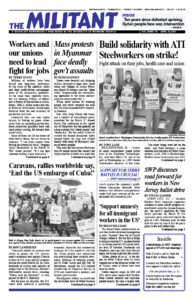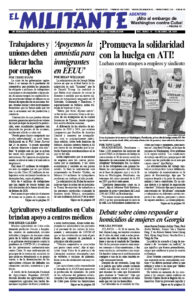Streets were deserted and shopping districts shuttered in large cities, small towns and villages all across Myanmar March 24 during a one day “silent strike,” demonstrating the overwhelming opposition to the brutal military junta that seized power Feb. 1.
When street actions by working people and youth resumed the next day, the junta responded with stepped-up violence.
Gen. Min Aung Hlaing told troops and a handful of international guests assembled for the March 27 Armed Forces Day celebration in the capital city of Naypyitaw that the generals are acting to protect the “ethnic people” and “democracy.” But the reality is they’ve crushed the limited democratic rights allowed before the coup and clashed sharply with many of Myanmar’s dozens of ethnic peoples.
That same day the regime killed more than 90 people around the country, the highest number of deaths in a single day since the coup, bringing the total deaths to over 500.
In a sign of the regime’s international isolation, only the Russian government sent a ministerial level delegation to the ceremony. Not even Beijing, Myanmar’s main trading partner and chief supplier of its military, sent a ranking official.
Cops and elite army units known for their brutality have opened fire on funerals for those killed by the regime, shot into hospitals and homes, killed youth on the street and chased and shot farmers who oppose the junta. At least 11 of those killed March 27 were children under 16.
Determination to defeat coup
The repression has increased the determination among working people to find a way to bring down the junta. Some workers and youth have been building more fortified barricades and some have even begun producing makeshift weapons, but those are no match for the regime’s firepower.
Soldiers fired rocket propelled grenades to destroy barricades thrown up in South Dagon Township, just north of Yangon, March 29. In Yangon’s Tamwe Township, “junta forces told people they will burn down their neighborhoods” if residents don’t stop nightly protests where they bang pots and pans, the Assistance Association for Political Prisoners reported.
The regime is also stepping up the pressure on strikers. Many of the hundreds of workers on strike at army-owned factories in five different towns that make parts for military vehicles have returned to work, but some organized slowdowns on the job or have quit.
On March 27 air force fighter jets attacked Day Pu Noe, a village in the southeastern region controlled by the Karen National Union, one of 18 armed forces tied to Myanmar’s ethnic minorities. These groups had been in negotiations with the government about extending cease-fires in place prior to the coup. Earlier in the day the Karen group overran an army base, killing 10 soldiers, including a lieutenant colonel.
Myanmar was under direct military rule from 1962 until 2011. As part of opening the country to foreign capital, the generals imposed a new constitution in 2008, leading to the first elections in decades. Starting in 2011, the military-dominated government passed labor laws that made it possible for trade unions to get legal recognition for the first time in decades. It also raised the minimum wage.
But to the generals’ surprise and chagrin, the National League for Democracy, a bourgeois opposition party led by Aung San Suu Kyi, swept the elections in 2015 and won by even bigger margins in 2020. As head of the government Suu Kyi — who had spent years under house arrest for her opposition to military rule — eliminated some undemocratic laws, but maintained others that date back to British colonial rule.
Myanmar’s trade union movement
“In many ways we are a very young trade union movement,” Khaing Zar Aung, president of the Industrial Workers Federation of Myanmar, told the Militant by phone March 29 from Germany, where she was when the coup took place. “Our union had grown to 24,000 members by 2019 in some 90 factories, mostly garment but also shoe, leather and household goods factories. But the membership of the unions overall has never been more than 0.5% of the workforce.”
Nothing changed for the unions with the election of Suu Kyi, Khaing Zar Aung said. “We still faced a lot of union busting. When we have a labor dispute, the law does not protect the union and its members.” After the coup many factory bosses turned over the names of union activists and leaders to the junta. Many union leaders have had to go into hiding, she said.
On March 14, 32 garment factories in Yangon’s industrial district were damaged in arson attacks. The junta used that as a pretext to step up repression in the surrounding working-class neighborhoods.
“Some 150,000 of the more than 600,000 garment workers have gone back to their home villages in rural areas as a result of the factory closings and the shootings every day by the military,” said Khaing Zar Aung. “But people will fight back wherever they are. I am confident they will stay united.”
Landless peasants
Some 70% of Myanmar’s people still live in the countryside where most homes don’t have electricity, cooking gas or indoor toilets. In 2012 the military-led government passed the Vacant, Fallow and Virgin Lands Management Act, which it used to aid foreign and local capitalists in evicting hundreds of thousands of farmers from land they had worked for generations.
The National League for Democracy promised prior to the 2015 election that it would return “illegally lost land.” But once in power it made the law stricter in 2018, adding a penalty of two-year prison sentences to anyone living on “vacant, fallow, and virgin land” without a permit. Getting a permit became a nightmare for millions of farmers, especially those from ethnic minorities whose first language isn’t Burmese.
The divisions among the 135 ethnic minorities and the Bamar majority are largely a legacy of the divide-and-rule strategy of the British rulers when Myanmar, then known as Burma, was a British colony. The rank and file soldiers of the army are mostly from the Bamar ethnic majority in rural areas.

